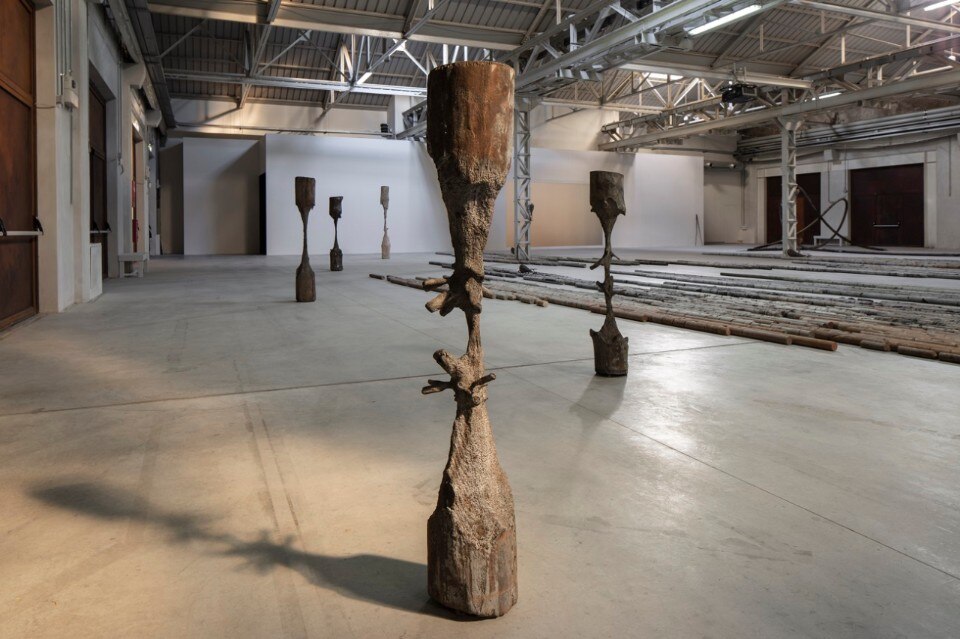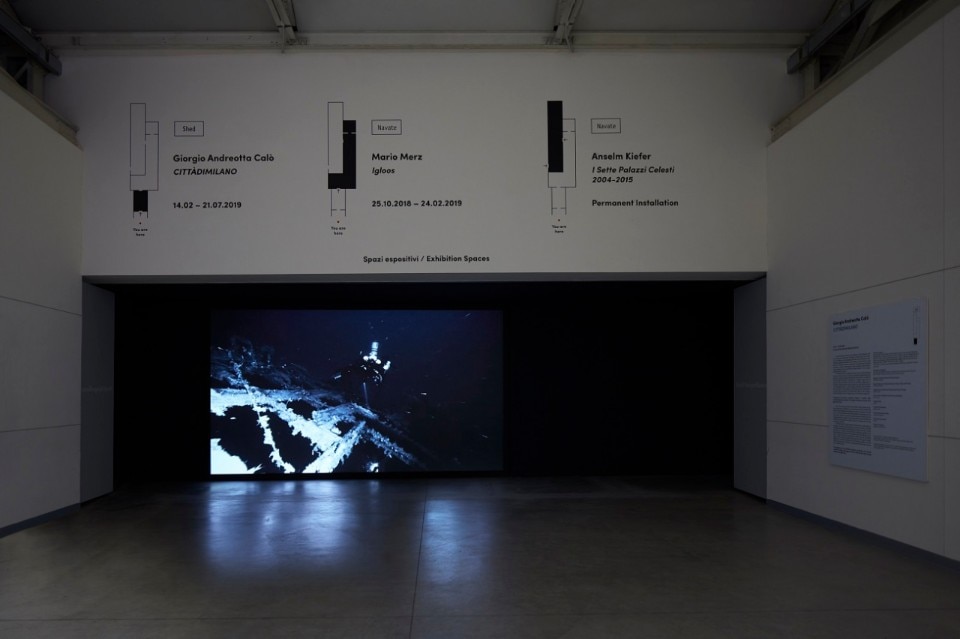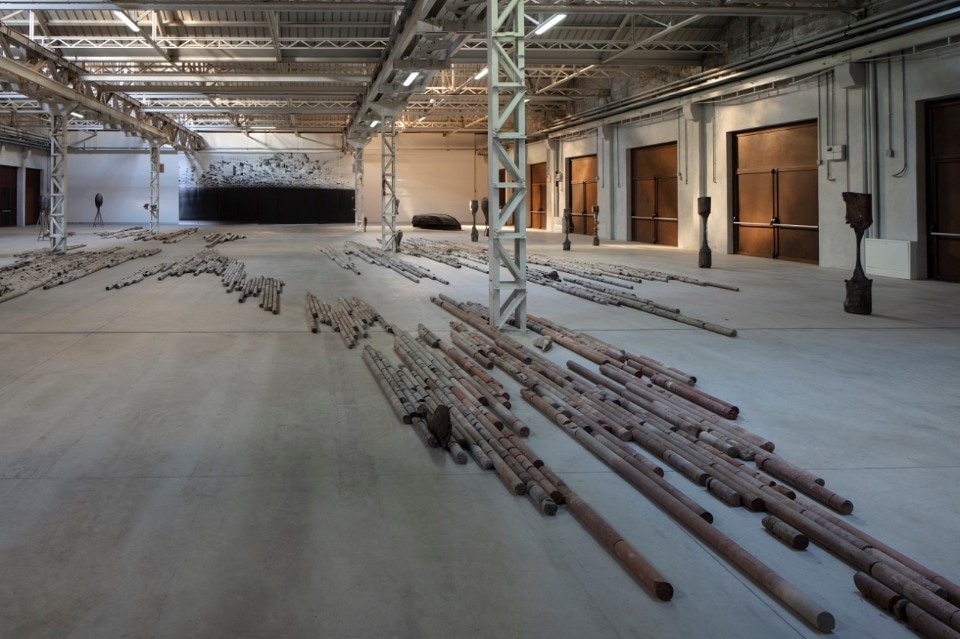Among unpublished works, realized after extensive researches developed in the Pirelli archives, and sculptures such as Meduse, such as Clessidre and Pinna Nobilis, Giorgio Andreotta Calò (Venice, 1979, lives and works in Italy and the Netherlands) returns to Italy for an institutional exhibition, after his presence at the 57th Venice Biennale (2017). On the occasion of CittadiMilano, we interviewed the artist on the meaning of an aesthetic landscape creation, where what was submerged becomes visible and what appears before the eyes, systematically disappears from human sight. Between horizontal planes and oblique perspective views.
During the last months researches, did you find forgotten data, about Milan, that you discovered and were not aware of?
From the beginning, I was meant to start from the history of Pirelli, from the work that they carried out and from the processes leading to the final realization of industrial products. The archive made me conscious about what Pirelli actually produces and, going back in time, we have even recovered a portion of submarine cable that was the first type of product engineered and built by the Italian Company.
On show, Senza Titolo (Cavi), 2019 was deliberately placed at the beginning of the path, and its horizontal section recalls the radial system of the tire bundle. An interweaving portion of metal fibres covered by rubber that shapes a structure. And observing the cable it could be revised the same torsion. The technical-productive forerunner of the tires has been the telegraph cable. The Company had distinguished itself on the market for the laying of submarine cables, a strong point that allowed us to get to the story of the steamboat, the CittàdiMilano, discovering that it had sunk.
It is a prelude for an idea of descent to a place that is not the physical, urban territory of the city, but it is a place that could be everywhere, even if it actually emerges a very strong bond with Venice. This has always been a method of investigation that I have carried out, mapping a space or a reality, referring to places that are familiar to me, and then characterizing them and connoting them in comparison to what is my personal experience and my way of pondering several realities. Milan is portrayed in the enormous photographic manifesto (Città di Milano, 2019), becoming inverted, a sort of seascape, with a horizon of a sea overturned in opposition. They are simply intersected places.
The works you are introducing from the past, they will have a predominantly sculptural imprinting. How, on your opinion the three-dimensional use of space will suspend the temporal dimension? The first approach of this exhibition underlines a close and consolidated link with Hangar Bicocca, a bond to its history, and partly to the structure of the exhibition space. The aim was understanding how the void was connoted, trying to interpret a geometry and a predisposition of the spaces that had been given, especially looking at their emptiness, at the beginning of everything.
The Shed’s space, from my point of view, tends to contain, to constrict what is placed in the middle. We should not conceive it as it is, but we should look at it from the outside, starting from the entrance, to realize that when a building is modified, even in its intended use, the initial perception is distorted. So this space, which, from the beginning, should have been a single compartment, so wide, long and low, today, partially fragmented, it has been changing its appearance, and has shrunk a lot, making everything emerged much more, put into the foreground.
We decided to give the visitor, as a first point of view, the extreme corner of the Shed, to identify a diagonal line. The intention is to allow perceiving a depth, by scanning a linear movement time which exactly get through the works. Therefore, starting from the physical arrangement of artworks in space, a crossing time is perceived, a journey that is no longer perpendicular to the two planes of the walls, but is oblique, transverse, and allows the whole environment to be read as a circularity. Entering the works and gradually passing through the system of the Carotaggi (2014-2017) we are made aware that we are driven by a continuous movement. For this reason we have left two benches on which we sit: we have turned it continuously, not so much to settle a job with respect to the other, but because we had the need to create moments of emptiness and suspension that become physical portions of time.
If you approach Volver, you will find a deliberately unfilled area, because from a density you switch to a pause. Following this concept, we have also overturned the image of Milan, because ideally we thought it could delineate a continuity with the core samples. But we understood that the fact of not perfectly identifying the sense of the represented image from the beginning would have stopped the visual research of the viewer, dilating the time, as in the vertical stratification of Carotaggi, positioned on the horizontal plane and therefore the sculptural form dialogues with its real temporal conformation. While Clessidre (M, N, O, B, U, AB), 2010-2013, mark the exact opposite, on the axis of verticality. The works are exact references about how time could look alike.

How much CittàdiMilano will be a parcours of surfacing and how much it will be immersive, through a dialogue among the last 10 years works? The view between the exterior and interior of the Shed is interrupted by the walls that continue the huge screen on which it is projected Senza Titolo (Jona), 2019. We have created a sort of initiation path, a moment of decompression, through a dark corridor, which allows access to the exhibition itself. It is an entry mode but it is also a request for attention, for preparation, for catching the details that would be lost if the visit route were too accelerated.
The film of the steamboat wreck, placed at the entrance, invites the spectator to a sort of ideal descent, a moment in which one enters an abyss and descends. Obviously the video represents a metaphorical transposition of what is perceivable at Hangar Bicocca: physical, tangible and objective presences. This separation created is clear at the beginning, when the exhibition is entered, but then the film is continually found among the elements installed in the space.
Furthermore, as the sun goes down, the moving image becomes more present than the other artworks. In fact, the temporal scanning of day and night becomes an element that we have left, in order it could reveal itself naturally. We did not want the space to be chilled, hypostatized by a fixed, natural or artificial light. It would have been enough to close the skylights, for example, to create a stable light, but the dimension of natural time is present in the works and must be maintained as a link with the outside. In any case, there is always a moment of entry, access to space, it must be mediated.
My works are set up without following a linear time scan, for example by date of production, so that the slides of Volver (2008) were placed close to the press of CittàdiMilano, realized a month ago, creating a sort of continuous circuit. We have only tried to find hypertextual dialogues between the works. In truth, every time someone move around the show, the point of view is changeable, creating different temporal axes. I like to think of the Shed as a kind of desk, on which there are folders where you have to immerse yourself, you have ot let yourself be submerged by information, creating links between the individual works, simply by navigating.

The term environmental applied to this monographic solo show, which meanings does it assume?
In this case, environmental means has to be related to Hangar Bicocca place and it finds analogies, correspondences. Last night, for example, regarding Senza Titolo (Jona) and its divers, I found it as a natural connecting part of the images of the wreck, with its metal structures, looking alike the Shed pylons. At that moment the drilling cores placed on the ground seemed to me a prosthetic continuation of the film. As if at some moments the environment became a single body, in which they find themselves melting artworks, becoming part of a larger ecosystem. The environment here is not just a landscape, a physical place, but represents a set of conditions in which a system can be developed, or shaped.
How are data and information broadcast through the exhibited works, from the cable to the drilling cores?
The data are simply fragments, incomplete segments. For us, receiving, assimilating a message means having inputs, short signals. Obviously, completion suggests a precise responsibility of our presence in space. The connection that can be built between what communicates a form or an element, the history that it contains, and what the coring can express, as well as the whole installation of the production, is revealed in the moment of separation between the one and the another, a small leap into the void represented by our thinking that connects them. We fill in the blanks through a personal reading of what surrounds us.
Talking about materials and surfaces constituting the Shed, there only bronze, wood, but also caranto (Venice Laguna mud) are visible, in an utopic transit between Milan and Venice. What are the qualities, the different responses that those three materials offer to you? The passage between one material and another implies the incipit of a transformation process. And to understand how from one element it becomes essential to move on to another, a moment of transition has to be fully observed. The fascination for caranto was born in order to humour my decision of analysis: I wanted to find out if that type of clay could have been fired, becoming terracotta. At the beginning I wanted to build masonry objects, with caranto. Although the implications of the alchemical order concerning the masonry had completely involved me.
Moreover, the object-column, its range, interested me because I was trying to reconstruct one load-bearing column. I was working for the Biennale in 2011 and the caranto, absolutely difficult to be extracted, has begun to become, in my mind, the backbone of Venice, the solid layer on which the city is founded. Extracting it in the form of cylinders, it means making it look like a column, while cooking it represents a subsequent moment, to fix it, because it easily crumbles.
However, the passage between the various materials is never clear and definitive, but sometimes some surfaces coexist with each other, between organic and inorganic, as when the shells are put together with the bronze part (Pinna Nobilis, 2016-2018), or when some bone sculptures become wood or even bronze. So it is a continuous, fluid and metamorphic passage: the work evolves without end, as it is told, for example, in the film with the miners In Girum Imus Nocte (2014). The change of state is a catalyst moment for an action: the boat that burns while the miners are walking is a symbol of the journey made between those who dig in the bowels of the earth and the fishermen. An element of water that turns into an element of earth. When the materials change without reaching a stable stage, in the next moment they are already transformed. In this sense, the exhibition creates a whirling movement, unable to offer visitors, even if they want it, a rest.
- Exhibition Title:
- Giorgio Andreotta Calò. CittàdiMilano
- Opening dates:
- From February 14 to July 21, 2019
- Curated by:
- Roberta Tenconi
- Venue:
- Hangar Bicocca
- Address:
- Via Chiese 2, 20100 Milan


